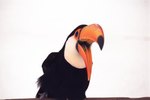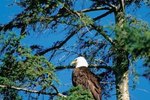
It's hard to imagine two more different birds than a turkey vulture and an eagle. The eagle has a majestic image, beloved in the US as the national emblem. The turkey vulture isn't quite as romanticized, often referred to as a buzzard. Despite their differences, both are graceful in flight.
Physical Description
You'll have no trouble distinguishing a turkey vulture from an eagle. When he's all grown up, the turkey vulture has a bald red head and ivory colored bill, topping off his dark black and brownish tones. As his name implies, he resembles a wild turkey when seen from a distance. The two most common eagles in the US, the bald eagle and golden eagle, are distinctive in their own ways. The bald eagle is easy to spot with his white head and white tail; the golden eagle is dark brown with golden brown plumage on his head and neck. The turkey vulture is smaller than both eagles, weighing only about 5 or 6 pounds with a 6-foot wingspan. The golden eagle has a wingspan ranging from 6 to 7.5 feet and he weighs between 6 and 15 pounds. The bald eagle's wingspan is a bit wider, going to 8 feet, and he weighs between 6.5 and 14 pounds.
Home
The bald eagle is a sea eagle, and is most abundant in Alaska and Canada. Look for him near water, such as coasts and lakes where fish are plentiful. The golden eagle, a land eagle, covers more ground and may consider home to be an area as large as 60 square miles. Mexico and much of western North America is where you're apt to find this guy; Asia, Europe and northern Africa also have populations of golden eagles. The turkey vulture has a widespread presence, found throughout the US, into Canada and into Central and South America. This fellow thrives in a mix of open and wooden areas, but can live just about anywhere, including deserts, coastlines, plains and inland tropical forests.
Diet
Turkey vultures are known as being nature's garbage men - eating the leftover dead animals that otherwise would go to rot. It's true this bird is a carrion lover, however, he does venture beyond dead animals occasionally, eating berries, insects, grapes and coyote feces. He's not known for eating live prey, unlike the golden eagle, which eats small animals such as squirrels and rabbits. The golden eagle also eats insects, other birds and fish. The bald eagle prefers fish, but will prey on smaller animals such as mice. He'll also steal another animal's kill. Neither eagle is above eating carrion, like the turkey vulture.
Useful Tools
Eagles in general have great eyesight, helpful for spotting and killing prey. The turkey vulture also has keen eyesight, however, he also has a sharp sense of smell, which comes in handy in his search for carrion. He has no feathers on his head, which helps when he eats. The turkey vulture often has to stick his head in the carcass to retrieve meat; feathers would complicate his feeding process. An eagle has strong, sharp talons for grasping and tearing prey, in contrast to the turkey vulture's weak feet. The turkey vulture's powerful beak makes up for his week feet, allowing him to tear through the toughest animal hide. Occasionally the turkey vulture will regurgitate his meal, leaving behind a mess with a foul, funky odor. This can help disgust potential predators as well as lighten his load, making him better able to take off in flight.
References
Photo Credits
-
Jupiterimages/Photos.com/Getty Images




